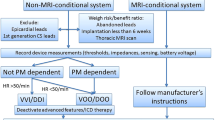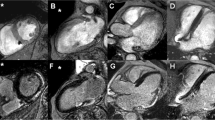Abstract
Purpose
Magnetic resonance imaging (MRI) has been safely performed in many patients with cardiac implantable electronic devices (CIEDs) using institution-specific protocols. A potential risk of MRI is myocardial heating and cardiac injury, which might be detectable with cardiac Troponin (cTn). We evaluated this in patients with CIEDs undergoing MRI.
Methods
Prospective data were collected from 2008 to the present in patients with CIEDs undergoing clinically indicated MRI performed under institutional protocol. Cardiac Troponin T (cTnT) levels were drawn both before and 24–36 h after the procedure. The collective data were retrospectively analyzed.
Results
MRI exams (n = 512) were performed in 398 patients. Of these, there were 348 unique scans with cTnT recorded before and after MRI (median age 68, IQ 56–78; 62 % men). cTnT did not significantly change for the group as a whole (0.00 ± 0.056). There were 22 (6.3 %) exams with cTnT change ≥0.002 ng/mL following MRI (range 0.01–0.09 ng/mL). There were no clinically significant events in these patients directly attributable to MR. There were no significant changes in pacing threshold or impedance in the group with elevated cardiac biomarkers.
Conclusion
There are very few situations where myocardial injury as detected by cTnT in patients undergoing MRI with CIEDs could be detected. No adverse clinical events or functional changes of the device were noted, even in those with increases in cTnT. Our experience supports that MRI can be performed safely for appropriately selected patients under close clinical observation. Proactive monitoring with the present iteration of cardiac biomarkers appears to be of limited utility, but prospective monitoring with high sensitivity assays may be able to detect subclinical myocardial damage.
Similar content being viewed by others
References
Roguin, A. (2009). Magnetic resonance imaging in patients with implantable cardioverter-defibrillators and pacemakers. J Am Coll Cardiol, 54(6), 556–557.
Kalin, R., & Stanton, M. S. (2005). Current clinical issues for MRI scanning of pacemaker and defibrillator patients. Pacing Clin Electrophysiol, 28(4), 326–328.
Boilson, B. A., Wokhlu, A., Acker, N. G., Felmlee, J. P., Watson, R. E., Jr., Julsrud, P. R., et al. (2012). Safety of magnetic resonance imaging in patients with permanent pacemakers: a collaborative clinical approach. J Interv Card Electrophysiol, 33(1), 59–67.
Friedman, H. L., Acker, N., Dalzell, C., Shen, W. K., Asirvatham, S. J., Cha, Y. M., et al. (2013). Magnetic resonance imaging in patients with recently implanted pacemakers. Pacing Clin Electrophysiol, 36(9), 1090–1095.
Higgins, J. V., Gard, J. J., Sheldon, S. H., Espinosa, R. E., Wood, C. P., Felmlee, J. P., et al. (2014). Safety and outcomes of magnetic resonance imaging in patients with abandoned pacemaker and defibrillator leads. Pacing Clin Electrophysiol, 37(10), 1284–1290.
Naehle, C. P., Kreuz, J., Strach, K., Schwab, J. O., Pingel, S., Luechinger, R., et al. (2011). Safety, feasibility, and diagnostic value of cardiac magnetic resonance imaging in patients with cardiac pacemakers and implantable cardioverters/defibrillators at 1.5 T. Am Heart J, 161(6), 1096–1105.
Naehle, C. P., Meyer, C., Thomas, D., Remerie, S., Krautmacher, C., Litt, H., et al. (2008). Safety of brain 3-T MR imaging with transmit-receive head coil in patients with cardiac pacemakers: pilot prospective study with 51 examinations. Radiology, 249(3), 991–1001.
Naehle, C. P., Strach, K., Thomas, D., Meyer, C., Linhart, M., Bitaraf, S., et al. (2009). Magnetic resonance imaging at 1.5-T in patients with implantable cardioverter-defibrillators. J Am Coll Cardiol, 54(6), 549–555.
Nazarian, S., Hansford, R., Roguin, A., Goldsher, D., Zviman, M. M., Lardo, A. C., et al. (2011). A prospective evaluation of a protocol for magnetic resonance imaging of patients with implanted cardiac devices. Ann Intern Med, 155(7), 415–424.
Sheldon, S. H., Bunch, T. J., Cogert, G. A., Acker, N. G., Dalzell, C. M., Higgins, J. V., et al. (2015). Multicenter study of the safety and effects of magnetic resonance imaging in patients with coronary sinus left ventricular pacing leads. Heart Rhythm, 12(2), 345–349.
Wilkoff, B. L., Bello, D., Taborsky, M., Vymazal, J., Kanal, E., Heuer, H., et al. (2011). Magnetic resonance imaging in patients with a pacemaker system designed for the magnetic resonance environment. Heart Rhythm, 8(1), 65–73.
Roguin, A., Schwitter, J., Vahlhaus, C., Lombardi, M., Brugada, J., Vardas, P., et al. (2008). Magnetic resonance imaging in individuals with cardiovascular implantable electronic devices. Europace, 10(3), 336–346.
Levine, G. N., Gomes, A. S., Arai, A. E., Bluemke, D. A., Flamm, S. D., Kanal, E., et al. (2007). Safety of magnetic resonance imaging in patients with cardiovascular devices: an American Heart Association scientific statement from the Committee on Diagnostic and Interventional Cardiac Catheterization, Council on Clinical Cardiology, and the Council on Cardiovascular Radiology and Intervention: endorsed by the American College of Cardiology Foundation, the North American Society for Cardiac Imaging, and the Society for Cardiovascular Magnetic Resonance. Circulation, 116(24), 2878–2891.
Jung, W., Zvereva, V., Hajredini, B., & Jackle, S. (2012). Safe magnetic resonance image scanning of the pacemaker patient: current technologies and future directions. Europace, 14(5), 631–637.
Achenbach, S., Moshage, W., Diem, B., Bieberle, T., Schibgilla, V., & Bachmann, K. (1997). Effects of magnetic resonance imaging on cardiac pacemakers and electrodes. Am Heart J, 134(3), 467–473.
Roguin, A., Zviman, M. M., Meininger, G. R., Rodrigues, E. R., Dickfeld, T. M., Bluemke, D. A., et al. (2004). Modern pacemaker and implantable cardioverter/defibrillator systems can be magnetic resonance imaging safe: in vitro and in vivo assessment of safety and function at 1.5 T. Circulation, 110(5), 475–482.
Luechinger, R., Zeijlemaker, V. A., Pedersen, E. M., Mortensen, P., Falk, E., Duru, F., et al. (2005). In vivo heating of pacemaker leads during magnetic resonance imaging. Eur Heart J, 26(4), 376–383.
Sommer, T., Naehle, C. P., Yang, A., Zeijlemaker, V., Hackenbroch, M., Schmiedel, A., et al. (2006). Strategy for safe performance of extrathoracic magnetic resonance imaging at 1.5 tesla in the presence of cardiac pacemakers in non-pacemaker-dependent patients: a prospective study with 115 examinations. Circulation, 114(12), 1285–1292.
Mollerus, M., Albin, G., Lipinski, M., & Lucca, J. (2008). Cardiac biomarkers in patients with permanent pacemakers and implantable cardioverter-defibrillators undergoing an MRI scan. Pacing Clin Electrophysiol, 31(10), 1241–1245.
Giannitsis, E., Kurz, K., Hallermayer, K., Jarausch, J., Jaffe, A. S., & Katus, H. A. (2010). Analytical validation of a high-sensitivity cardiac troponin T assay. Clin Chem, 56(2), 254–261.
Higgins, J. V., Sheldon, S. H., Watson, R. E., Jr., Dalzell, C., Acker, N., Cha, Y. M., et al. (2015). “Power-on resets” in cardiac implantable electronic devices during magnetic resonance imaging. Heart Rhythm, 12(3), 540–544.
Sommer, T., Vahlhaus, C., Lauck, G., von Smekal, A., Reinke, M., Hofer, U., et al. (2000). MR imaging and cardiac pacemakers: in-vitro evaluation and in-vivo studies in 51 patients at 0.5 T. Radiology, 215(3), 869–879.
Langman, D. A., Goldberg, I. B., Finn, J. P., & Ennis, D. B. (2011). Pacemaker lead tip heating in abandoned and pacemaker-attached leads at 1.5 Tesla MRI. J Magn Reson Imaging, 33(2), 426–431.
Babuin, L., & Jaffe, A. S. (2005). Troponin: the biomarker of choice for the detection of cardiac injury. Cmaj, 173(10), 1191–1202.
Saunders, J. T., Nambi, V., de Lemos, J. A., Chambless, L. E., Virani, S. S., Boerwinkle, E., et al. (2011). Cardiac troponin T measured by a highly sensitive assay predicts coronary heart disease, heart failure, and mortality in the Atherosclerosis Risk in Communities Study. Circulation, 123(13), 1367–1376.
Financial support
Funded entirely by Mayo Clinic.
Author information
Authors and Affiliations
Corresponding author
Rights and permissions
About this article
Cite this article
Higgins, J.V., Watson, R.E., Jaffe, A.S. et al. Cardiac troponin T in patients with cardiac implantable electronic devices undergoing magnetic resonance imaging. J Interv Card Electrophysiol 45, 91–97 (2016). https://doi.org/10.1007/s10840-015-0064-7
Received:
Accepted:
Published:
Issue Date:
DOI: https://doi.org/10.1007/s10840-015-0064-7




